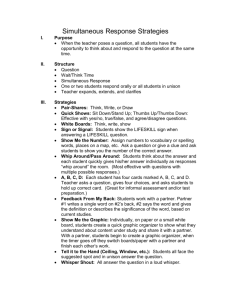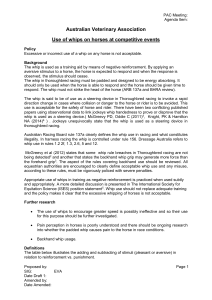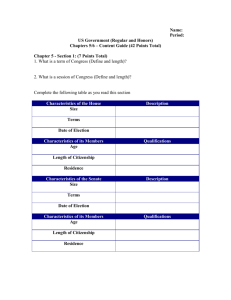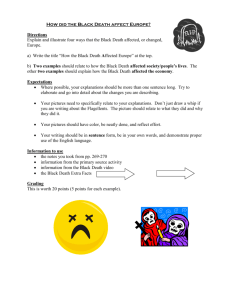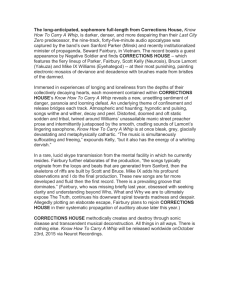Party Voting and the Institutionalization of the Whip System
advertisement
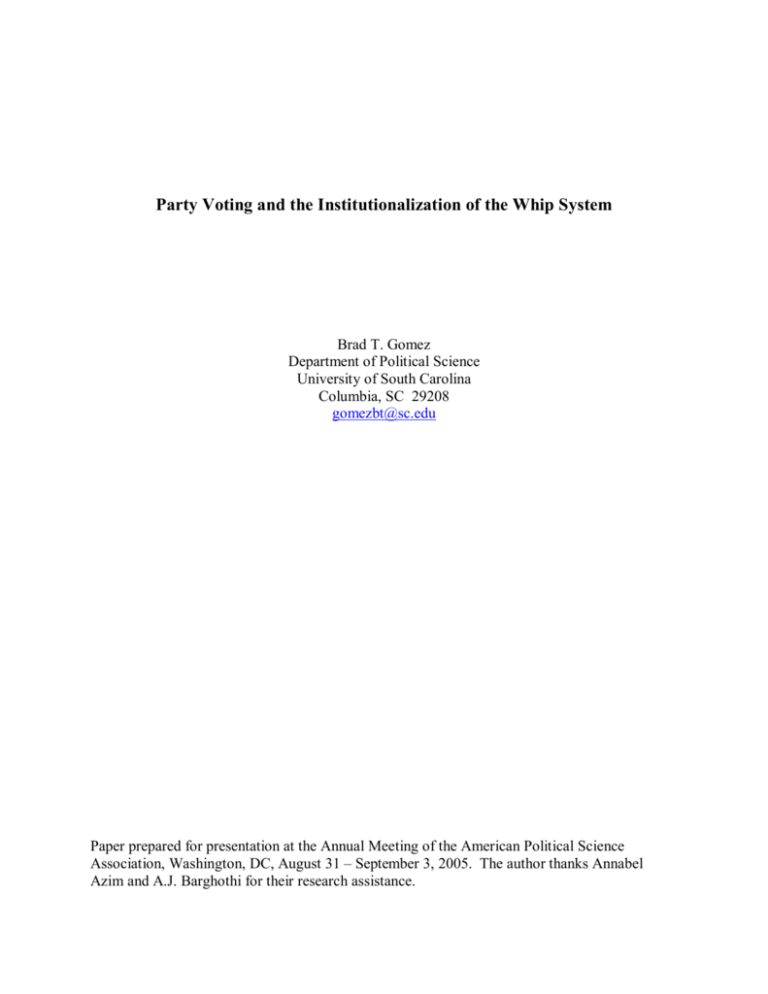
Party Voting and the Institutionalization of the Whip System Brad T. Gomez Department of Political Science University of South Carolina Columbia, SC 29208 gomezbt@sc.edu Paper prepared for presentation at the Annual Meeting of the American Political Science Association, Washington, DC, August 31 – September 3, 2005. The author thanks Annabel Azim and A.J. Barghothi for their research assistance. In his classic work, Congressional Government, Woodrow Wilson (1885) famously described power within the United States House of Representatives as being decentralized among the chairs of the standing committees. Indeed, so great was their authority that Wilson characterized the chairs as “47 seigniories, in each of which a standing committee is the court-baron and its chairman lord proprietor” (1885, 76). One of the great ironies of this assessment of congressional government as being “committee government” is that it came to print just as the House entered into its most intense period of party government. Scholars routinely describe 1890–1910 as being the zenith of party government in the United States (e.g., Rohde 1991; Schickler 2001). The power of parties during the period, especially congressional Republicans, was manifest in both institutional arrangements and legislative behavior. Procedural change began with the succession of Republican Thomas Brackett Reed of Maine as Speaker of the House during the 51st Congress. Despite his party only holding a slim majority, Reed successfully pursued an aggressive partisan agenda by stripping the minority party of its ability to obstruct House business. By reinterpreting House procedures and establishing “Reed’s Rules,” the Speaker and his Republican majority passed sweeping changes in tariff, pension, and monetary policies. Reed’s Rules also greatly increased the authority of the Speaker vis-àvis the committee chairs. Though many of Reed’s Rules were subsequently repealed by a short-lived Democratic majority, minority obstruction was again repressed when the Republican majority restored the so-called “quorum rule” in 1894. Republicans also strengthened the gate-keeping capacity of the Rules Committee and the Speaker’s dominance over the Committee during the period. Behaviorally, partisanship amongst 1 legislators reached an all-time high, as partisans of both camps routinely voted to support their leaders on both procedural and policy matters (Brady and Althoff 1974). Indeed, according to Eric Schickler, “if one focuses solely on the 1890 roll calls, partisanship explains all of the variance in members’ votes” (2001, 33). During this intense period of party government, each party also sought to strengthen the hand of its leadership. In addition to the consolidation of procedural authority, each party developed organizationally, as the Republicans, followed shortly thereafter by the Democrats, created the floor leader and party whip positions. Each of these positions, and the latter especially, was charged with coordinating the collective action of the parties and demanding compliance from party members. While much has been written about the development of the floor leader position (e.g., Polsby 1968; Canon 1989), particularly regarding its untangling from committee power, remarkably little scholarship exists on the emergence and influence of party whips (a notable exception being Ripley 1964).1 The paucity of research on the party whips is remarkable oversight primarily because scholars have long been interested in explaining party voting and cohesion within Congress—the forging of which is primary mobilization function of party whips.2 To be sure, there are complexities involved in studying the role of party whips in forging partisan loyalty, and these difficulties may be responsibility for our weak understanding of the party whips. First, historical identification of the whips and especially their assistants has been a non-trivial enterprise. Indeed, the Congressional 1 Before its official designation in 1899, the de facto floor leader of the majority party was the Chair of the Appropriations Committee in earlier congresses, later followed by the Chair of Ways and Means. 2 Within the House leadership structure, the Majority Whip is the third ranking member of his party (behind the Speaker and Majority Leader, while the Minority Whip is the second only to the Minority Leader. 2 Research Service notes that the official record of Democratic whips is actually incomplete and that it is “almost impossible to identify all deputy whips, regional whips, and zone whips who have been appointed” (Rundquist, Sachs, and Bullock 2002, 4). A second issue concerns how to operationalize whip activity. Simple nominal measures designating each whip are virtually useless in explaining the variance in party voting over time. While there may be discernible regime shifts in party voting attributable to the designation of new party whips, such empirical evidence would not lead us to explain why some whips might be more affective than others. This operational difficulty may have limited the place of whip activity in studies of aggregate levels of party voting. 3 At the bill level, few researchers have broached the difficult task of coding archival records of whipping activity on specific bills.4 Consequently, we know very little about when parties “whip” their members, who gets “whipped,” or the whip’s capacity for demanding compliance. This leaves legislative scholarship on party voting in a precarious state— almost all existing models of party voting and cohesion do not incorporate the activities of the party leader charged with forging partisan loyalty and compliance. This is a regrettable omission. 3 One method for incorporating the whip into a model of party voting is pursued by Cox and McCubbins ( 1991; 1993). These authors use the voting agreement between the floor leader and party whip as a way of identifying and measuring “party votes.” Given similar ideological preferences, it is likely that the simple agreement measure provides an inflated estimate of the number of party votes, i.e., votes on which the party attempts to muster support from the rank-and-file (see Krehbiel 2000 for a similar argument). 4 By “whipping activity” I mean the utilization of “whip counts,” the private polls of partisans conducted by the leadership prior to major floor votes on issues of importance to the party. Records of whipping activity in the form of “whip sheets” or “tally sheets” can be found in the archival records some, but not all, of the former party whips. Ripley (1964) and Burden and Frisby (2004) have each employed small samples of this type of data to examine the effect of whipping on party voting—with mixed results. The most ambitious attempt to codify the historical record of whipping activity is currently being undertaken by Lawrence Evans of the College of William and Mary and is funded by the National Science Foundation. Evans expects to gather whip sheets for the House Democrats from 1955 to 1986 and House Republicans from 1973 to 1980. 3 This paper attempts to explain the influence of party whips on party voting in the United States House of Representatives. In the sections that follow, I first examine the activities and historical development of the party whip system. I do not attempt to offer a complete history of the leadership position, but rather I look to the development of the system as a way of informing a theoretical understanding of the role of the party whip. I then turn to theory and offer an explanation for party whip influence grounded in the logic of the median voter theorem (Black 1958; Downs 1957). Specifically, I argue that party theory suggests that whips who are ideologically proximate to the median voter in their party are better able to signal the party’s position. As a result, it is expected that party voting and cohesion will increase as the absolute distance of the whip to his party median decreases. I analyze the effect of whips on partisan behavior in multiple ways. First, I examine party voting during the historical period in which the whip positions in the parties were formally institutionalized. I search for a structural break in the data, expecting that party voting increased after the official creation of the whip position. I then model party unity and cohesion in the House from the 55th to the 107th Congress. I conclude with a discussion of the paper’s results and ideas for future work The Evolution of Party Whips in the House As noted by Ripley, “the name ‘whip’ derives from the British fox-hunting term ‘whipper-in,’ used to describe the man responsible for keeping the hounds from leaving the pack” and was first applied in the British Parliament around 1770 (1964, 562). The responsibility of the huntsman is an apt corollary to the compliance function of the legislative whip, though modern whips also serve an informative function. Today’s whips are centralized sources of legislative and party information, providing members of 4 their respective parties with information on upcoming legislation, the leadership’s position on legislation (if applicable), and partisan policy positions and talking points. Whips are also responsible for mustering fellow partisans to the floor before voting. Yet, the primary function of the whips remains compliance. Since the position’s inception, the whip has been charged with polling members of the party on how they plan to vote on key legislation and lobbying those in the rank-and-file who are undecided or plan to vote in opposition to the party. Though not formally defined as a party official until 1987, most of the functions of the party whip have been performed in the House of Representatives since the first Congress. The historical record suggests that James Madison polled his (Jeffersonian) Republican allies over their support for Jay’s Treaty during the early days of the republic (Chernow 2004, 499). Ripley characterizes the whip process during this informal period as haphazard—“many of these whips were volunteers for a given floor fight only” (1964, 562). Though he appears to have served informally as Republican whip in earlier years, James Tawney of Minnesota was the first member of the House to be formally recognized as his party’s whip. The exact circumstances surrounding Tawney’s formal designation are unclear, but the formalization of the position was one of several methods for centralizing authority during Thomas Reed’s second stint as Speaker of the House. During his initial service as Speaker in the 51st Congress, Reed empowered his slim party majority by restricting the parliamentary rights of the Democratic minority (Reed’s Rules). Public opposition to Reed’s “Czar”like tactics, resulted in a loss of Republican majority status in the elections of 1890 and 5 Reed’s Rules were overturned under Democratic Speaker Charles F. Crisp. But when Republicans regained a majority in 1894, Speaker Reed reinstalled some of his rules and began to formally centralize partisan leadership positions, creating what Schickler refers to as an “interlocking directorate” (2001, 56). In 1897, Reed named Tawney the Majority Whip, and in 1899, he designated Sereno E. Payne (R-NY) as the first Majority Leader on the floor. Shortly following Reed’s official designation of the party leadership positions, the Democrats formally recognized their leadership team. James D. Richardson of Tennessee became the Minority Leader and Oscar W. Underwood of Alabama became Minority Whip. Underwood only held the position officially for one year, but his biography suggests that he served informally as whip before being formally named. An interesting puzzle surrounds the designation of the Democratic whip for the decade encompassing the 61st through 66th Congresses. The Congressional Record during this period recognizes Thomas Bell of Georgia as the Democratic Whip during the 63rd Congress, but no official designation can be found for the remaining sessions. Some scholars believe Bell served from 1909 to 1919 (Berhdahl 1949), while others believe John Nance Garner of Texas may have been whip (Timmons 1948). On its face the debate may seem just a curiosity, but historical newspaper sources might clarify the issue, while adding further to our understanding of the institution’s development. A New York Times article dated August 7, 1909, identifies Bell as being Whip during the 61st Congress and also identified Garner and William Hughes of New Jersey as Bell’s “assistant whips.” This could possibly explain the confusion over who held the official designation. The Times identifies Bell as whip for all of the Congresses in question 6 except for the last, the 66th Congress, when Garner is identified as whip (New York Times, April 1, 1920). Perhaps most interesting, the Times’ identification of the assistant whips is confirmation of the existence of these positions during this period.5 I follow the Times’ designations in my data. Because of their contemporaneous institutionalization, I present a list of both whips and floor leaders, which can be found in Tables 1 – 4. Among the whips, the average length of service among the Democrats is approximately two terms, while the average for Republicans is about 3.3 terms. The shortest and longest terms of service both belong to Republicans. Current Vice President, Richard B. “Dick” Cheney, served as Minority Whip for roughly three months before becoming Secretary of Defense under President George H. W. Bush. The longest term of service belongs to Republican Leslie Arends of Illinois, who served as party whip for fifteen congressional sessions, all but two of those as Minority Whip. [Insert Tables 1 – 4 about here] More recently, some scholars have argued that the whip system has been an important component in achieving heightened levels of partisanship (Rohde 1991; Sinclair 1983, 1995). Democrats during the 1970s and 1980s expanded the number of assistant whips, which allowed for broader information exchange and an increased capacity to count votes (Dodd 1979; Rohde 1991).6 Republicans countered Democratic expansion of their whip system during the period with similar efforts. Perhaps most notably, the Republican Whip Newt Gingrich merged an aggressive public persona with 5 Ripley states that Underwood had an assistant, but there were no others until 1929, under Whip John McDuffie. 6 Rohde notes that the expansion whip system, which grew in size from roughly 10% of the Caucus in the 93rd Congress to around 40% of the Caucus in the 101st Congress, was also a “direct response to demands among members for broader participation and input into party decisions” (1991, 90). 7 strong efforts to forge partisan compliance and led the GOP out of minority status in the House for the first time in nearly fifty years. But do party whips actually result in increased levels of party line voting and cohesion? Unlike the huntsman who carries a whip, the legislative whip possesses only weak enforcement mechanisms for keeping “potentially recalcitrant lawmakers on the partisan reservation” (Evans et al 2003, 36). According to Evans et al. (2003), the legislators most likely to convert to the party position after being “whipped” are those who were previously undecided. Legislators who stand in opposition to the party leadership prior to being whipped are less likely to convert, perhaps due to strong ideological or constituency pressure. In rare and sometimes notable cases, the party leadership does “crack the whip” and punish a rebel. In 1983 for instance, the Democratic Party leadership disciplined Representative Phil Gramm (D-TX), after Gramm was unresponsive to whip pressure and began to lead efforts to pass the economic program of Republican President Ronald Reagan. For his actions, the Democratic Steering and Policy Committee of the House, which contains the party whip and his deputy whips, denied Gramm retention of his seat on the House Budget Committee (Baker 1985). Gramm later left the party. Whips and Party Theory After years of declining partisanship in both Congress and the electorate, political parties have rebounded to positions of significant influence. This resurgence in parties has been mirrored by renewed scholarly interest in parties and a healthy debate about their role and influence in Congress. Beginning with the influential work of Joseph Cooper and David Brady (1981), one prominent stream of theory has examined the 8 conditional nature of party government. Cooper and Brady argued that legislators’ willingness to strengthen the hand of party leaders and toe the party line was a function of the degree of party polarization in the electorate and within Congress. This argument was carried further by David Rohde (1991), whose “conditional party government” theory argues that when preferences within the majority party are homogeneous and ideologically distinct from preferences within the minority party, the majority party may be able to secure non-centrist preferences that more accurately reflect the party’s position (the party median). To be sure, Rohde’s conditional party government relies heavily on exogenous forces, but the theory also requires that party leaders manage the aggregation of their partisans’ preferences through strong mechanisms of agenda control and behavior coercion. The whip system is fundamental to the latter mechanism. The role of the whips in managing party governance is also evident in the “party cartel” theory offered by Gary Cox and Mathew McCubbins (1993). For these authors, legislators form political parties so as to accrue the electoral benefits that may follow from collective action—pooled resources and the informative benefits that stem from the party’s “brand name” for example. To secure the benefits of collective action, Cox and McCubbins argue that partisans willingly empower their leaders with the ability to coordinate action and demand compliance. Once again, the party whip is a vital player in fostering the collective goals of the party. Though the conditional party government and party cartel theories differ in their initial assumptions, each tells a similar story about the expected role of party whips. That whips play a critical role in attaining partisan unity is obvious, but perhaps less obvious is the whips’ importance in signaling the median preference within the party. Within each 9 of the party caucuses, the aggregation of preferences—assuming a single preference dimension—is governed by the median voter theorem. That is, if we treat each party in isolation, we expect collective agreement to center on the position offered by the median voter within the group. The application of this logic is especially easy to accept when one considers situations in which the party caucus casts a vote on policy alternatives under majority rule. If party policy positions are dictated by party leaders and are not determined endogeneously by caucus vote, a situation more common before the reform era of the 1970s, theory suggests that policy positions that coincide with the preferences of the median voter in the party will maximize support among partisans. Thus, to extent that the majority party is able to secure its preference through procedural control or behavioral compliance, the expected equilibrium location for the party’s preferred outcome is located at the median voter within the party caucus. We might also expect that when whips are chosen by a vote of the party caucus, candidates closest to the median voter in the party will be most likely to win. As a result, there is strong theoretical reason to believe that whips who mirror the median preference within their party are likely to stimulate increased levels of support from partisans. This suggests a fusion, of sort, between the whip’s compliance and informative functions. That is, when a whip can clearly signal the median position within his party, stable coalitions should arise and party voting should be relatively higher than when whips diverge from median. Data To examine the effect of the party whips on party voting and cohesion in the House of Representatives, I collected data for the period of congressional history 10 beginning with the 40th session and ending in 107th session. Two fundamental issues govern the historical length of my case selection. First, to adequately test whether the institutionalization of the whip system in the 55th Congress increased the mean level of partisanship in the House, I needed a sufficiently large number of pre-55th Congresses. I choose the 40th Congress as a starting point because it occurred roughly at the beginning of the reconstruction period and marks the resumption of a stable two party system. The analysis employs three main dependent variables. First, I examine whether the institutionalization of the whip system, which occurred at roughly the same time for both parties, corresponds with an increase in party voting. The party voting variable measures the percentage of all roll call votes where at least 50% of the Democrats opposed at least 50% of the Republicans. I then examine the effect of whip signaling on party unity and party cohesion. In both cases, I test whether whips who are proximate ideologically to the median voter in their party increase unity and cohesion within the party. The party unity variable is the average percentage of partisans who voted with their party majority on “party votes.” The party cohesion measure is the Rice Index of Cohesion and measures the average absolute percentage of partisans voting “yes” subtracted from partisans voting “no.” These data were made public by Joseph Cooper and Garry Young and can be found at Professor Cooper’s website (http://jhunix.hcf.jhu.edu/~jcooper/papers.html). To measure the ideological position of each of the whips, each of the party floor leaders, and their party medians, I use Poole and Rosenthal’s (1997) DW-NOMINATE scores. These measures range from –1 to 1 with those positions marking the most extreme liberal and conservative positions respectively. Given that party theory typically 11 concentrates on the unidimensional ideological space, I only employ the first dimension DW-NOMINATE scores, which according to Poole and Rosenthal an underlying economic ideological dimension. To measure the Party Whip Signal and Party Leader Signal, I simply took the absolute distance between the respective leader’s ideological position and that of their party’s median member. Figures 1 and 2 illustrate the placement of the party whips and floor leaders vis-àvis their party medians respectively. As can be seen in Figure 1, both Democratic and Republican whips have routinely been more ideologically extreme than their party median. Yet, in both cases, it would be unfair to characterize the whips as being ideological “extremists.” A similar assessment can be made about the relative placement of the parties’ floor leaders. As evident in Figure 2, ideological extremists do not appear to find their way into party leadership roles. For Democrats, the floor leader has always been a tad more liberal than his median follower, but, for Republicans, the floor leader has been more moderate than his followers about one-third of the time. It is useful, of course, to note that both whips and floor leaders frequently approach the ideological placement of their party median, giving some credence to the median signaling argument. Whether this signal affects party unity and cohesion remains to be seen. [Insert Figures 1 and 2 about here] The party unity and party cohesion models employ a set of variables that have been previously shown to affect each of these dependent phenomena. Democratic Majority is a dichotomous variable scored “0” when Republicans hold a majority in the House and “1” when Democrats are the majority party. Democratic President is similarly scored “0” for Republican presidents and “1” for Democratic presidents. In 12 both cases, I expect that Democrats’ (Republicans’) party unity and cohesion will increase during periods when Democrats (Republicans) control either the House or the presidency. In equations that model Democratic behavior, I attempt to control for the presence of cross-pressured Southern Democrats within the party’s ranks. The measure is a dummy variable that is coded “1” for all sessions beginning with the 81st Congress and ending with the 102nd Congress. The measure attempts to measure the period of Southern Transition—that is, the period of time most associated with white Southern Democratic defection from party voting and eventually the party ranks. The 81st Congress came on the heels of Harry Truman’s desegregation of the military and marks the beginning of his attempt to place desegregation on the Democratic Party platform. The 102nd Congress marks an end to white Southern Democratic migration to the Republican Party at the congressional level (Hill and Rae 2000). Admittedly, this measure is less than ideal and is one that I hope to improve in future iterations of this paper by using the actual number of white Southern Democrats in the House. Nevertheless, I expect the Democrats’ party unity and party cohesion scores to be significantly lower during this period. In past work on party voting patterns in the Senate, Patricia Hurley and Rick Wilson (1989) show that membership turnover significantly increases aggregate levels of party cohesion. The authors argue that freshmen legislators tend to vote with their party at significantly higher levels than veteran legislators. Accordingly, the Electoral Turnover variable measures the number of freshmen joining the legislative party in each congress. 13 Lastly, I incorporate the Number of Partisans within each party so as to capture the difficulty of achieving collective action in large groups. Because of well-known coordination problems, I expect that as the number of partisans increases, party unity and cohesion will go down. Results Institutional Change in Party Voting In Table 4, I examine the effect of formal institutionalization of the whip and floor leader positions on party voting in the House of Representatives during the 55th Congress.7 The models provided are simple tests for structural breaks in the party voting time series. In each of the estimations, the Institutional Break variable is coded “1” for Congresses beginning with the 55th and “0” otherwise. The first model searches for a structural break in the immediate period following the institutionalization by examining only the 50th through 60th Congresses. The results suggest that significant increase in party voting during the immediate period can be attributed to the formal institutionalization of the party leadership positions. Party voting in the five congresses that immediately follow institutionalization is 13 percentage points higher than in the four congresses that preceded it. Of course, because the whip and floor leader designations occurred at nearly contemporaneous moments in time, we cannot attribute the increase to one leader versus the other. [Insert Table 4 about here] 7 Officially, the Democrats did not formally designate their whips until the 56th Congress, but I have chosen to test for only one structural break in the data. In alternative models, I set the institutional break at the 56th Congress, and the results are nearly identical to those provided here. Those models are available from the author upon request. 14 If the institutionalization of the leadership positions did stimulate higher levels of party voting, it effect clearly was not sustained. When the time period under investigation is expanded to the 40th through 107th Congresses, it is clear that on average party voting since institutionalization has been significantly lower than before the official designation of the positions. Because of a significant negative trend in the dependent variable, I ran this model with and without a lagged dependent variable. The lagged variable shows a 57% proportional reduction in party voting with each succeeding year— a sharp decline. Most importantly, though the magnitude of the institutional break variable varies across model specification, in both cases party voting is shown to be significantly lower during the post-institutionalization period—a long term result that runs counter to the logic for institutionalizing the positions. Whip Signals and Party Unity in the House In this section, I present the results for alternative models of party unity in the House of Representatives. In both models, the period under investigation extends from the 55th Congress, the first after official designation of the Republican whip, to the 107th Congress. The variability of party unity, the dependent variable, over time is evident in Figure 3. In the post-institutionalization period (designated to the right of the vertical line, the long period of partisan decline followed by a recent return to partisan government outlined by Rohde is clearly visible. Indeed, amongst Republicans in the 107th Congress, the level of party unity has risen to levels exhibited during the “Czarist” rule of Reed and Cannon. [Figure 3 about here] 15 Each of the models in this section is estimated using Zellner’s (1962) Seemingly Unrelated Regression (SUR) estimation. The estimator allows for the Democratic and Republican party unity equations to be estimated simultaneously, while also allowing the residuals from each equation to be correlated. Model 1 and Model 2 differ from one another only in that the latter includes a measure of the floor leaders’ absolute distance from the party median in addition to the similarly constructed whip signal. Both Models 1 and 2 in Table 5 provide significant fits to the data. In both models, Republican partisans in the House appear to respond well to their majority status when it is achieved. If we transpose the interpretation of the Democratic Majority variable, we see that Republicans are significantly more unified when they hold majority status than when they are in the minority. Surprisingly, Democratic unity appears to be unaffected by their status in the majority or the minority. Interestingly, Republicans appear to be a more unified opposition to Democratic presidents than unified supporters of their presidents from their own party—a result not expected, but interesting nonetheless. Once again, Democratic unity does not seem to be affected in a manner similar to the Republicans. The president’s party appears to be unrelated to Democratic party unity. In fact, the Democratic equations appears to be sensitive to model specification. For instance, while appropriately negative in both models, the southern transition variable is significant only in Model 2. Alternatively, the variable measuring the number of partisans is only statistically significant in the first model. [Insert Table 5 about here] Of course, the variables of greatest interest here are the party whip and floor leader signal variables. In Model 2, but only among Democrats, the floor leader signal 16 appears to behavior in a manner consistent with theory. That is, as the Democratic floor leader becomes closer to the median voter within the party, party unity among partisans increases significantly. Yet, when we turn our attention to the party whip signal variable, the results are striking. In this case, high levels of party unity appear to be associated with ideological extremism, i.e., movement away from the median. This result is not consistent with the theoretical model presented here, but it does offer some interesting alternatives. One possibility is that the party rank-and-file is more fearful of retribution from their more ideological extreme leader. Perhaps more ideologically extreme whips provide more credible commitments to punish than whips who are less ideological. Alternatively, is could be that the signaling between whips and the partisans tends to follow a more directional pattern, where more extreme information is more clearly conveyed. Whip Signals and Party Cohesion in the House In Table 6, I examine the effect of whip and floor leader signaling on partisan cohesion. Unlike the party unity measure, which considers the average coalition size on party votes, the party cohesion scores measure the absolute percentage of partisans voting together over the course of the Congress. Because the denominator includes “party votes,” those votes in which 50% of one party votes against 50% of the other party, and “non-party votes,” one might expect that party cohesion will be a weaker measure of party consolidation than the party unity. This is not necessarily the case, since non-party votes also include bi-partisan coalitions. Consequently, the party cohesion measure captures party-stimulated coalescences and that which might simply be behaviorally routine or preferentially consensual. 17 [Insert Table 6 about here] With this admonition in mind, one might expect that variables that measure party pressure might be weaker in relation to party cohesion than party unity, but as we see in Table 6, party pressure is substantively important nonetheless. The behavior exhibited in the party cohesion models, is similar to that found in the party unity model though a bit more consistent across equations. Once again, Republican partisans seem responsive to general governance pressures: majority status and presidential partisanship (as opposition) significant affect Republicans’ level of party cohesion. Perhaps without surprise, size pressures continue to weaken Democratic coherence; as the number of Democrats increase, the party has a more difficult time keeping the troops together. However, these models exhibit unexpected and inconsistent behavior with regard to Democratic reaction to white Southern Democratic pressures. In model 1, the data suggest that Democratic cohesion was significantly higher during the period of Southern transition. This, of course, is unexpected and may be a result of substantial bipartisan (or cross-pressured) politics during the period. Yet, this effect no longer remains significant in the more fully specified model number two. The story associated with the leadership signaling variables is similar to before. Once again, model 2 suggests that Democratic cohesion seems to respond to median signaling from the party floor leader. This result is expected from theory in that the party median signal is the most efficient (it is in equilibrium) signal of the party’s position on the floor. But, similar to before, the party whips—in this case for both parties—do not appear stimulate coalescent behavior by signaling the median. Instead, whips who are more ideologically extreme than their partisans seem to stimulate the rank-and-file to 18 work together.8 As mentioned above, this may be a sign that more ideological whips signal a more credible commitment to punish than their less ideological counterparts, but this explanation requires further exploration and greater theorizing. Discussion The paper presented here offers an examination of the effect of party whips on partisan coalition building. It joins a growing list of studies to examine the topic (e.g., Burden and Frisby 2004; Evans et al 2003), and this would appear to be a useful trend in legislative scholarship. The last decade or so has brought about a renewed interest in legislative partisanship. Once considered a relatively inconsequential component of the American Congress, party government and the conditions that foster it appear to be on the rise (see Krehbiel 1993; 1999 for an opposing viewpoint). To date, most studies of partisan behavior in Congress have focused on the distribution of legislative preferences and use of procedural power as stimulants for increased party voting, while only a few have attempted to incorporate the party whip into these models. Given that party whip’s are charged with both informing partisans of party leadership preferences and increasing rank-and-file compliance with leadership preferences, the institutions exclusion from models of party voting seems somewhat remiss. In this paper, I have examined the effect of party whips on party voting in three ways. First, I demonstrated that the institutional formalization of the party whip position (coupled with the floor leader position) in approximately the 55th Congress seems to have 8 The whip signal measure actually captures absolute distance from the party median, but I use the directional argument “more ideologically extreme” because this is the most common placement of whip, as shown in Figure 1. To substantiate this use of language I estimated the models using a directional corollary to the whip signal measure, and as expected negative (more liberal) values were associated with higher levels of Democratic cohesion and positive (more conservative) values were associated with higher levels of Republican cohesion. 19 stimulated levels of party voting in the short term. Yet, the increase in party voting that occurred directly after the formalization of the leadership positions was short-lived, as levels of party voting during the first two-thirds of the twentieth century dropped precipitously after its high point at the turn of the century. I then tested the claim that the party whip signals his party’s median position as a way of simulating party unity and party cohesion. The findings from the empirical models do not coincide, however, with our traditional theoretical understanding of role of the party median. While Democratic floor leaders do appear to signal the party median, the results presented here suggest that effective whip leadership results from more ideologically extreme signaling. That is, Democratic whips are more liberal and Republicans whips are more conservative than their respective median partisans are more likely to stimulate internal party unity and cohesion. Instead of signaling the party’s equilibrium preference, whips appear to signal the credibility of their commitments. The credible commitment conjecture, of course, assumes that whips can actually punish and reward partisan behavior, and, in this paper, I have assumed this capacity to not only exist, but to also be constant over the period of investigation. It is entirely possible that the power of the whip to reward compliance and met out punish to the recalcitrant may have changed over time. To date, there are no good measures of this whip capacity, but future study of this issue seems warranted. One approach to studying the whip’s compliance capacity may be an examination of the organizational structure of the entire whip system. The party whip’s compliance capacity may be a function of his organizational resources: monetary resources, the number of assistant whips in the organization, the hierarchical arrangement of these assistants, the ideological similarity of 20 the assistants to the party whip (a possible measure of good agency), etc. All of these considerations would seem to be a useful avenue of study for increasing our knowledge of how parties as organizations within government work. 21 References Baker, Ross K. 1985. “Party and Institutional Sanctions in the U.S. House: The Case of Congressman Gramm.” Legislative Studies Quarterly 10:315-337. Berdahl, Clarence. 1949. “Some Notes on Party Membership in Congress.” American Political Science Review 43:309-321. Black, Duncan. 1958. The Theory of Committees and Elections. New York: Cambridge University Press. Brady, David W., and Phillip Althoff. 1974. “Party Voting in the U.S. House of Representatives, 1890-1910.” Journal of Politics 36:753-75. Burden, Barry D., and Tammy M. Frisby. 2004. “Preferences, Partisanship, and Whip Activity in the U.S. House of Representatives.” 29: 569-90. Canon, David T. 1989. “The Institutionalization of Leadership in the U.S. Congress.” Legislative Studies Quarterly 14:415-443. Chernow, Ron. 2004. Alexander Hamilton. New York: Penguin Books. Cooper, Joseph, and David W. Brady. 1981. “Institutional Context and Leadership Style: The House from Cannon to Rayburn.” American Political Science Review 75:41135. Cox, Gary W., and Mathew D. McCubbins. 1991. “On the Decline of Party Voting in Congress.” Legislative Studies Quarterly 16:547-70 Cox, Gary W., and Mathew D. McCubbins. 1993. Legislative Leviathan: Party Government in the House. Berkeley, CA: University of California Press. Dodd, Lawrence C. 1979. “The Expanded Roles of the House Democratic Whip System: The 93rd and 94th Congresses.” Congressional Studies 7:27-56. Downs, Anthony. 1957. An Economic Theory of Democracy. New York: Harper and Row. Evans, C. Lawrence, Douglas D. Roscoe, Timothy M. Deering, and Michael D. O’Neill. 2003. “The House Whip Process and Party Theories of Congress: An Exploration.” Paper Presented at the Annual Meeting of the American Political Science Association, Philadelphia, PA. Hill, Kevin A., and Nicol C. Rae. 2000. “What Happened to the Democrats in the South?: U.S. House Elections, 1992-1996.” Party Politics 6:5-22. 22 Hurley, Patricia A., and Rick K. Wilson. 1989. “Partisan Voting Patterns in the U.S. Senate, 1877-1986.” Legislative Studies Quarterly 14:225-250. Krehbiel, Keith. 1993. “Where’s the Party?” British Journal of Political Science 23:23566. Krehbiel, Keith. 1999. “Paradoxes of Parties in Congress.” Legislative Studies Quarterly 24:31-64. New York Times. “House Democrats United.” August 7, 1909. New York Times. “Resolution to End our State of War Put Before House.” April 1, 1920. Polsby, Nelson W. 1968. “The Institutionalization of the U.S. House of Representatives.” American Political Science Review 62:144-68. Poole, Keith T., and Howard Rosenthal. 1997. Congress: A Political Economic History of Roll Call Voting. New York: Oxford University Press. Ripley, Randall B. 1964. “The Party Whip Organization in the United States House of Representatives.” American Political Science Review 58:561-576. Rohde, David W. 1991. Parties and Leaders in the Postreform House. Chicago: University of Chicago Press. Rundquist, Paul S., Richard C. Sachs, and Faye M. Bullock. 2002. CRS Report for Congress: Party Leaders in Congress, 1789-2002: Vital Statistics. Washington DC: Congressional Research Service. Schickler, Eric. 2001. Disjointed Pluralism: Institutional Innovation and the Development of the U.S. Congress. Princeton, NJ: Princeton University Press. Sinclair, Barbara. 1983. Majority Leadership in the U.S. House. Baltimore, MD: Johns Hopkins University Press. Sinclair, Barbara. 1995. Legislators, Leaders, and Lawmaking: The U.S. House of Representatives in the Postreform Era. Baltimore, MD: Johns Hopkins University Press. Timmons, Bascom N. 1948. Garner of Texas. New York: Wilson, Woodrow. 1885. Congressional Government. Boston: Houghton Mifflin. Zellner, Arnold. 1962. “An Efficient Method of Estimating Seemingly Unrelated Regressions and Tests of Aggregation Bias.” Journal of the American Statistical Association 57:500-509. 23 TABLE 1. House Democratic Floor Leaders, 1899-2003. Floor Leader James D. Richardson John Sharp Williams James B. “Champ” Clark Oscar W. Underwood Claude Kitchin James B. “Champ” Clark Claude Kitchin Finis J. Garrett John Nance Garner Henry T. Rainey Joseph W. Byrns William B. Bankhead Sam T. Rayburn John W. McCormack Sam T. Rayburn John W. McCormack Sam T. Rayburn John W. McCormack Carl Albert Thomas Hale Boggs Thomas P. O’Neill, Jr. James Wright Thomas S. Foley Richard A. Gephardt State TN MS MO AL NC MO NC TN TX IL TN AL TX MA TX MA TX MA OK LA MA TX WA MO Congress 56th – 57th 58th – 60th 60th – 61st 62nd – 63rd 64th – 65th 66th 67th 68th – 70th 71st 72nd 73rd 74th 75th – 76th 76th – 79th 80th 81st – 82nd 83rd 84th – 87th 87th – 91st 92nd 93rd – 94th 95th – 99th 100th – 101st 101st – 107th Source: Congressional Research Service. † Elected Speaker of the House. 24 Dates 1899 – 1903 1903 – 1908 1908 – 1911 1911 – 1915 1915 – 1919 1919 – 1921 1921 – 1923 1923 – 1929 1929 – 1931 1931 – 1933 1933 – 1935 1935 – June 4, 1936† 1937 – Sept. 16, 1940† 1940 – 1974 1947 – 1949 1949 – 1953 1953 – 1955 1955 – Jan. 10, 1962† 1962 – 1971 1971 – 1973 1973 – 1977 1977 – 1987 1987 – June 6, 1989† 1989 – 2003 TABLE 2. House Democratic Whips, 1901-2003. Whip Oscar W. Underwood James T. Lloyd Thomas M. Bell John Nance Garner William A. Oldfield John McDuffie Arthur Greenwood Patrick J. Boland Robert Ramspeck John J. Sparkman John W. McCormack J. Percy Priest John W. McCormack Carl Albert Thomas Hale Boggs Thomas P. O’Neill, Jr. John J. McFall John W. Brademas Thomas S. Foley Tony Coelho William H. Gray, III David E. Bonior State AL MO GA TX AR AL IN PA GA AL MA TN MA OK LA MA CA IN WA CA PA MI Congress 56th 57th – 60th 61st – 65th 66th 67th – 70th 70th – 72nd 73rd 74th – 77th 77th – 79th 79th 80th 81st – 82nd 83rd 84th – 87th 87th – 91st 92nd 93rd – 94th 95th – 96th 97th – 99th 100th – 101st 101st – 102nd 102nd – 107th Dates 1901 1901 – 1908† 1909 – 1919* 1920 – 1921 1921 – Nov. 19, 1928‡ 1928 – 1933 1933 – 1935 1935 – May 18, 1942‡ 1942 – Dec. 31, 1945† 1946 – 1947 1947 – 1949 1949 – 1953 1953 – 1955 1955 – 1962 1962 – 1971 1971 – 1973 1973 – 1977 1977 – 1981 1981 – 1987 1987 – Jun 14, 1989† 1989 – Sept. 11, 1991† 1991 – 2003† Source: Congressional Research Service and The New York Times. * There is no official record in the minutes of the Democratic Caucus or elsewhere of the name of the Democratic Whip for the 61st through 66th Congresses, with the exception of the 63rd Congress, where Thomas Bell is officially recognized as the Whip. Some scholars believe that Bell may have been the whip for the entirety of this period, while others believe the Whip was John Nance Garner of Texas. Historical articles from The New York Times suggest that Garner, along with William Hughes of New Jersey, served as Bell’s Assistant Whips (the first such designation). † Resigned from office on date given or end of session. ‡ Died in office on date given. 25 TABLE 3. House Republican Floor Leaders, 1899-2003. Floor Leader Sereno E. Payne James R. Mann Franklin W. Mondell Nicholas Longworth John Q. Tilson Bertrand H. Snell Joseph W. Martin, Jr. Charles Halleck Joseph W. Martin, Jr. Charles Halleck Joseph W. Martin, Jr. Charles Halleck Gerald R. Ford John J. Rhodes Robert H. Michel Richard K. Armey State NY IL WY OH CT NY MA IN MA IN MA IN MI AZ IL TX Congress 56th – 61st 62nd – 65th 66th – 67th 68th 69th – 71st 72nd – 75th 76th – 79th 80th 81st – 82nd 83rd 84th – 85th 86th – 88th 89th – 93rd 93rd – 96th 97th – 103rd 104th – 107th Dates 1899 – 1911 1911 – 1919 1919 – 1923 1923 – 1925 1925 – 1931 1931 – 1939 1939 – 1947 1947 – 1949 1949 – 1953 1953 – 1955 1955 – 1959 1959 – 1965 1965 – Dec. 6, 1973† 1973 – 1981 1981 – 1995 1995 – 2003 Source: Congressional Research Service. † Resigned from the House of Representatives to become the Vice President of the United States. 26 TABLE 4. House Republican Whips, 1897-2003. Whip James A. Tawney James E. Watson John W. Dwight Charles H. Burke Charles M. Hamilton Harold Knutson Albert H. Vestal Carl G. Bachmann Harry L. Englebright Leslie C. Arends Robert H. Michel Trent Lott Richard B. “Dick” Cheney Newton L. “Newt” Gingrich Thomas D. DeLay State MN IN NY SD NY MN IN WV CA IL IL MS WY GA TX Congress 55th – 58th 59th – 60th 61st – 62nd 63rd 64th – 65th 66th – 67th 68th – 71st 72nd 73rd – 78th 78th – 93rd 94th – 96th 97th – 100th 101st 101st – 103rd 104th – 107th Dates 1897 – 1905 1905 – 1909 1909 – 1913 1913 – 1915 1915 – 1919 1919 – 1923 1923 – 1931 1931 – 1933 1933 – May 13, 1943‡ 1943 – 1975 1975 – 1981 1981 – 1989 1989 – Mar. 17, 1989† 1989 – 1995 1995 – 2003 Source: Congressional Research Service and The New York Times. † ‡ Resigned from office on date given or end of session. Died in office on date given to become U.S. Secretary of Defense. 27 TABLE 4. Effect of Whip and Floor Leader Institutionalization on Party Voting in the U.S. House of Representatives. Variables Constant Institutional Break Congressional Period 50th – 60th 40th – 107th 60.67** 67.62** (8.29) (3.26) 13.65* (8.29) -13.33** (3.69) Party Voting t-1 Adj R2 N 40th – 107th 28.62** (7.39) -5.82* (3.39) 0.57** (0.10) .14* 11 .15** 68 .42** 67 Source: Cooper and Young Data (http://jhunix.hcf.jhu.edu/~jcooper/papers.html). The dependent variable, Party Voting, measures the percentage of all roll call votes where at least 50% of the Democrats opposed at least 50% of the Republicans. Cell entries are OLS estimates and standard errors are in parentheses. * p < .05 ** p < .01, one-tailed test 28 TABLE 5. Model of Party Unity in the U.S. House of Representatives, 55th – 107th Congress Model 1 Model 2 Democrats 94.50** (5.01) Republicans 89.92** (5.83) Democrats 93.97** (5.41) Republicans 88.80 ** (5.86) Democratic Majority 0.07 (2.30) -9.04** (1.69) -0.47 (2.35) -8.35** (1.74) Democratic President 0.53 (1.62) 3.10** (1.17) -0.47 (1.70) 3.00** (1.19) Southern Transition -1.95 (1.73) --------- -3.45* (1.84) --------- Electoral Turnover 0.03 (0.02) -0.01 (0.02) 0.02 (0.02) -0.01 (0.02) Number of Partisans -0.06* (0.03) -0.02 (0.02) -0.04 (0.04) -0.02 (0.02) Floor Leader Signal --------- --------- -22.17* (11.65) 4.62 (8.07) Party Whip Signal 17.47* (9.53) 20.22** (8.69) 15.70 (9.50) 21.91** (9.14) Variables Constant 0.30** 4.92, p = 0.03 Correlation of Residuals (re1e2) Breusch-Pagan Test for ,QGHSHQGHQFH R2 N 0.29** 4.41, p = 0.04 2 0.42** 53 0.58** 53 0.45** 52 0.48** 52 Note: The models are estimated using Zellner’s Seemingly Unrelated Regression. Source: Cooper and Young Data (http://jhunix.hcf.jhu.edu/~jcooper/papers.html). The dependent variable, Party Unity, is the average percentage of partisans who voted with their party majority on “party votes.” Cell entries are OLS estimates and standard errors are in parentheses. * p < .05 ** p < .01, one-tailed test 29 TABLE 6. Model of Party Cohesion in the U.S. House of Representatives, 55th – 107th Congress Model 1 Variables Constant Model 2 Democrats 88.30** (7.48) Republicans 83.99** (8.01) Democrats 90.72** (8.00) Republicans 83.61** (7.90) Democratic Majority -0.61 (3.42) -13.76** (2.32) -0.75 (3.46) -13.88** (2.33) Democratic President 2.05 (2.41) 3.04** (1.59) 0.70 (2.49) 3.59** (1.58) Southern Transition 5.77* (2.60) --------- 3.33 (2.75) --------- Electoral Turnover 0.04 (0.03) 0.01 (0.02) 0.04 (0.03) 0.01 (0.02) Number of Partisans -0.12** (0.05) -0.04 (0.03) -0.10* (0.05) -0.04 (0.03) -42.44** (17.45) -17.92 (11.01) 36.86** (14.26) 31.44** (12.48) Floor Leader Signal --------- Party Whip Signal 37.64** (14.32) Correlation of Residuals (re1e2) Breusch-Pagan Test for ,QGHSHQGHQFH R2 N --------19.62* (11.98) 0.23** 2.87, p = 0.09 0.09** 0.37, p = 0.54 2 0.27** 53 0.59** 53 0.35** 52 0.62** 52 Note: The models are estimated using Zellner’s Seemingly Unrelated Regression. Source: Cooper and Young Data (http://jhunix.hcf.jhu.edu/~jcooper/papers.html). The dependent variable, Party Cohesion, is the Rice Index of Cohesion and measures the average absolute percentage of partisans voting “yes” subtracted from partisans voting “no.” Cell entries are OLS estimates and standard errors are in parentheses. * p < .05 ** p < .01, one-tailed test 30 FIGURE 1. Ideological Locations of the Party Whips and Party Medians, 55th – 107th Congress. 1 DW-Nominate .5 0 -.5 Congress Democratic Median Democratic Whip Republican Median Republican Whip Source: Poole and Rosenthal D-W Nominate Scores (Voteview.com). 31 107 95 85 75 65 56 -1 FIGURE 2. Ideological Locations of the Floor Leaders and Party Medians, 55th – 107th Congress. 1 DW-Nominate .5 0 -.5 Congress Democratic Median Democratic Floor Leader Republican Median Republican Floor Leader Source: Poole and Rosenthal D-W Nominate Scores (Voteview.com). 32 107 95 85 75 65 56 -1 70 75 Party Unity Scores 80 85 90 95 FIGURE 3. Party Unity Scores in House of Representatives, 40th – 107th Congress. 40 60 80 Congress Democratic Unity 100 120 Republican Unity Source: Cooper and Young Data (http://jhunix.hcf.jhu.edu/~jcooper/papers.html). Note: The vertical line marks the beginning of the whip system in the U.S. House of Representatives in the 55th Congress 33



